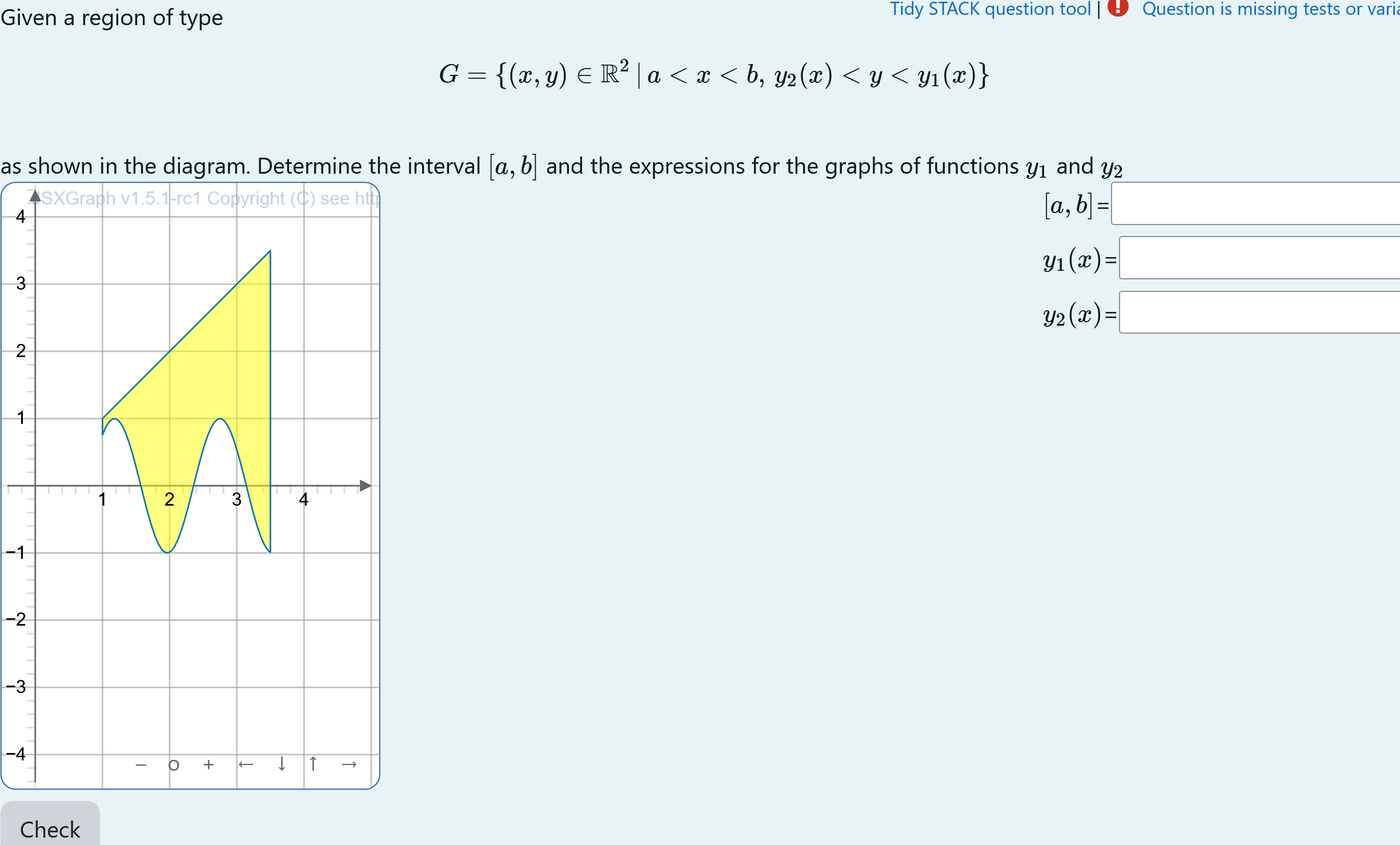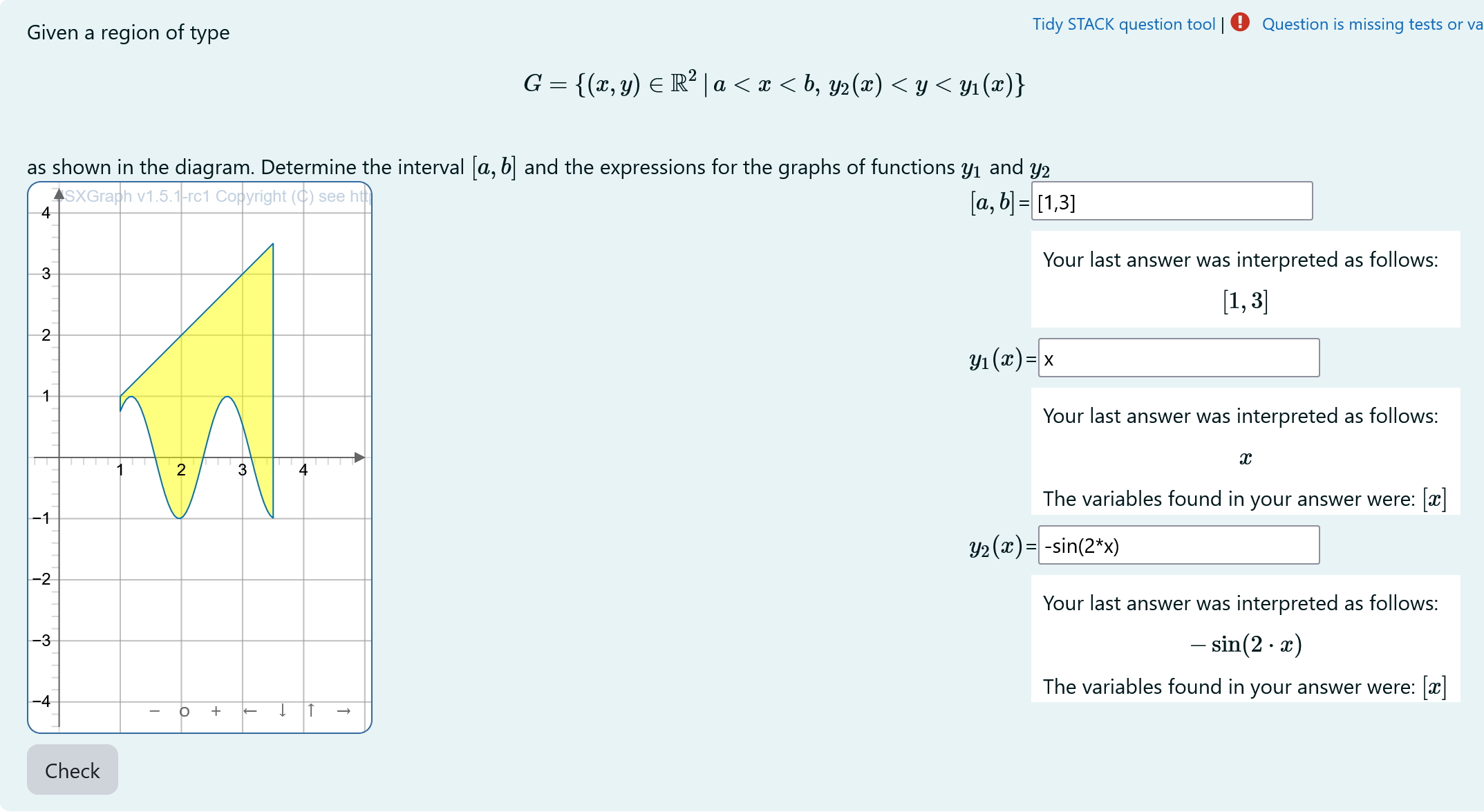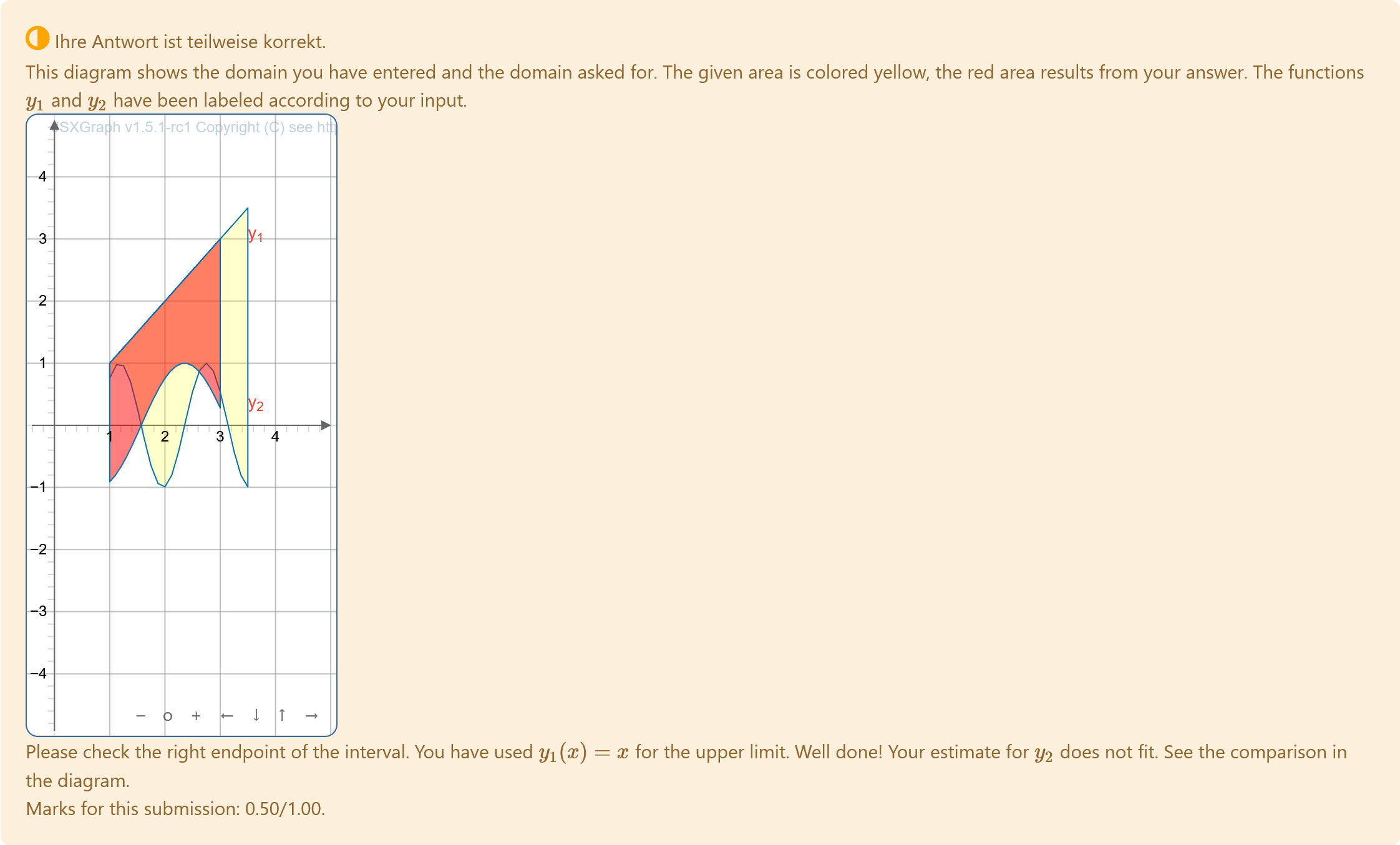Integration region of type I
Integration region of type I
Aim of task
- Student can formulate the function term and the domain for elementary functions given by a graph (Modelling, Handling mathematical symbols and formalism)
- Student can think of an area that is given by the area between to functions and is able to formulate the expressions for graphically given region (represent mathematical entities, posing and solving mathematical problems, making use of aids and tools)
 |
|---|
| First impression of the question |
Question description
A 2D figure is plotted. It is a randomly generated section
The task is to find the correct intervalls for $r$ and $\phi$ in real numbers that construct the generated figure in polar coordinates.
Student perspective
The student will see a coordinate systems.
It is the aim to find the functions describing the given area and there domain.
 |
|---|
| When the student solves the problem |
Feedback
|  |
|:–:|
| Feedback |
|
|:–:|
| Feedback |
Teacher perspective
The teacher is able to give a list of possible functions for $y_1$ (yupperfun) and $y_2$ (ylowerfun). In order to do this, they need to modify the entries in the lists specified e.g. change yupperlist and ylowerlist.
The domain of the functions $y_1$ and $y_2$ is defined by x1 and x2. To adopt this the teacher has to change the corresponding lines.
It may happen, that the functions $y_1$ and $y_2$ will intersect. The size of the JSXGraph applet is adjusted using width and height and bounding box.
 |
|---|
| The above image shows which values the teacher may wish to change |
Question code
Question Variables
Question variable code
/* interval [x1,x2] */
x1:rand(4)/2;
x2:(rand(4)+3)/2+x1;
yupperlist:[x,(x-x1)^2/2+1,sin(4*x)+2];
ylowerlist:[-x,-(x-x1)^2/2+2,-sin(4*x)];
yupperfun:rand(yupperlist);
ylowerfun:rand(ylowerlist);
Question Text
- Task explanation using LaTex
-
Region described by general formulation $$G ={(x,y)\in\mathbb{R}^2\, \, a < x < b,\, y_2(x) < y < y_1(x)}$$ - JSXGraph applet using the functions and variables defined in Question variables plotting the randomized integration region.
[[input:ans1]] [[validation:ans1]]domain for the functions $y_1$ and $y_2$[[input:ans2]] [[validation:ans2]]upper function $y_1$[[input:ans3]] [[validation:ans3]]lower function $y_2$
Question text code
Given a region of type
\[G =\{(x,y)\in\mathbb{R}^2\, |\, a < x < b,\, y_2(x) < y < y_1(x)\}\]
as shown in the diagram. Determine the interval \([a,b]\) and the expressions for the graphs of functions \(y_1\) and \(y_2\)
<div style='float:right'>
<p>\([a,b]\)=[[input:ans1]] [[validation:ans1]]</p>
<p>\(y_1(x)\)=[[input:ans2]] [[validation:ans2]]</p>
<p>\(y_2(x)\)=[[input:ans3]] [[validation:ans3]]</p>
</div>
[[ jsxgraph width="250px" height="400px"]]
var b1 = JXG.JSXGraph.initBoard(divid,{boundingbox: [-0.5,4.5,5.1,-4.5],grid:true, axis:true,keepAspectRatio:true});
// some variables
var nSubDivCurv = 51; // number of points to represent a curve -1
var cIntArea // Integration area to be plotted by curves of the entered functions
var yLower, yUpper;
var txtraw;
var xlp = b1.jc.snippet('{#x1#}', false, 'x', false); // random left interval
var xup = b1.jc.snippet('{#x2#}', false, 'x', false); // random right interval
b1.suspendUpdate();
// to be replace be function from STACK
txtraw = '{#ylowerfun#}';
//txtraw = '0';
txtraw = txtraw.replace(/\s/g, "");
yLower = b1.jc.snippet(txtraw, true, 'x', false);
// to be replace be function from STACK
txtraw = '{#yupperfun#}';
//txtraw = '1';
txtraw = txtraw.replace(/\s/g, "");
yUpper = b1.jc.snippet(txtraw, true, 'x', false);
cIntArea = b1.create('curve', [[], []], { strokeWidth: 1, fillColor: 'yellow', fillOpacity: 0.5 });
cIntArea.updateDataArray = function () {
// generate upper curve
var hx = (xup - xlp) / (nSubDivCurv);
var pt = xlp;
this.dataX = [xlp];
this.dataY = [yUpper(xlp)];
for (let i = 1; i <= nSubDivCurv; i++) {
pt = xlp + i*hx;
this.dataX.push(pt);
this.dataY.push(yUpper(pt));
}
// add yLower between xu and xl
var hx = (xup - xlp) / (nSubDivCurv);
var pt = xup;
for (let i = 0 ; i <= nSubDivCurv ; i++) {
pt = xup - i*hx;
this.dataX.push(pt);
this.dataY.push(yLower(pt));
}
// close the curve
this.dataX.push(this.dataX[0]);
this.dataY.push(this.dataY[0]);
}; // end cIntArea.updateDataArray
b1.unsuspendUpdate();
[[/ jsxgraph ]]
Answers
Answer ans 1
| property | setting |
|---|---|
| Input type | Algebraic input |
| Model answer | [x1, x2] defined in Question variables |
| Forbidden words | none |
| Forbid float | Yes |
| Student must verify | Yes |
| Show the validation | Yes, with variable list |
Answer ans 2
| property | setting |
|---|---|
| Input type | Algebraic input |
| Model answer | yupperfun defined in Question variables |
| Forbidden words | none |
| Forbid float | Yes |
| Student must verify | Yes |
| Show the validation | Yes, with variable list |
Answer ans 3
|property | setting|
|:—|:—|
|Input type | Algebraic input|
|Model answer | ylowerfun defined in Question variables |
| Forbidden words | none |
| Forbid float | Yes |
| Student must verify | Yes |
| Show the validation | Yes, with variable list|
—
General feedback
None
Potential response tree
prt1
 |
|---|
| Display of prt1 |
Feedback variables:
r1:ans1[1]
r2:ans1[2]
Node 6
| property | setting |
|---|---|
| Answer Test | AlgEquiv |
| SAns | 0 |
| TAns | 1 |
| Node 1 true feedback | none |
| Node 1 false feedback | <p>This diagram shows the domain you have entered and the domain asked for. The given area is colored yellow, the red area results from your answer. The functions \(y_1\) and \(y_2\) have been labeled according to your input. </p>This node generates a diagram showing the given region and the region from students answer. |
|  |
|:–:|
| Values of node 6 of prt 1 |
|
|:–:|
| Values of node 6 of prt 1 |
[[ jsxgraph width="250px" height="500px"]]
var b2 = JXG.JSXGraph.initBoard(divid,{boundingbox: [-0.5,5,5.1,-5],grid:true, axis:true});
// students answer: Interval ans1, y_1 = ans2 (upper limit), y_2 = ans3 (lower limit)
var xlp2, xup2, txtraw2;
// get intervals from question variables and students answer
var nSubDivCurv = 20;
xlp2 = b2.jc.snippet('{#x1#}', false, 'x', false); // random left interval
xup2 = b2.jc.snippet('{#x2#}', false, 'x', false); // random right interval
var xlpStud2 = b2.jc.snippet('{#ans1[1]#}', false, 'x', false);
var xupStud2 = b2.jc.snippet('{#ans1[2]#}', false, 'x', false);
// get lower functions from question variables and student's answer
txtraw2 = '{#ylowerfun#}';
txtraw2 = txtraw2.replace(/\s/g, "");
var yLower2 = b2.jc.snippet(txtraw2, true, 'x', false);
txtraw2 = '{#ans3#}';
txtraw2 = txtraw2.replace(/\s/g, "");
var yLowerStud2 = b2.jc.snippet(txtraw2, true, 'x', false);
// get upper functions from question variables and student's answer
txtraw2 = '{#yupperfun#}';
txtraw2 = txtraw2.replace(/\s/g, "");
var yUpper2 = b2.jc.snippet(txtraw2, true, 'x', false);
txtraw2 = '{#ans2#}';
txtraw2 = txtraw2.replace(/\s/g, "");
var yUpperStud2 = b2.jc.snippet(txtraw2, true, 'x', false);
// add text to show student's answer
var textx2 = xupStud2+0.5;
var texty2 = yLowerStud2(xupStud2) + 0.1;
var textf2 = b2.create('text', [textx2, texty2, 'y_2'], {
strokeColor: '#EE442F',fontsize:14
});
var textx3 = xupStud2+0.5;
var texty3 = yUpperStud2(xupStud2) + 0.1;
var textf3 = b2.create('text', [textx3, texty3, 'y_1'], {
strokeColor: '#EE442F',fontsize:14
});
// b2.suspendUpdate();
var cIntArea2 = b2.create('curve', [[], []], { strokeWidth: 1, fillColor: 'yellow', fillOpacity: 0.2 });
var cIntAreaStud2 = b2.create('curve', [ [], []], { strokeWidth: 1, fillColor: 'red', fillOpacity: 0.5});
cIntArea2.updateDataArray = function () {
// generate upper curve
let hx = (xup2 - xlp2) / (nSubDivCurv);
let pt = xlp2;
this.dataX = [xlp2];
this.dataY = [yUpper2(xlp2)];
for (let i = 1; i <= nSubDivCurv; i++) {
let pt = xlp2 + i*hx;
this.dataX.push(pt);
this.dataY.push(yUpper2(pt));
}
// add yLower between xu and xl
hx = (xup2 - xlp2) / (nSubDivCurv);
pt = xup2;
for (let i = 0 ; i <= nSubDivCurv ; i++) {
pt = xup2 - i*hx;
this.dataX.push(pt);
this.dataY.push(yLower2(pt));
}
// close the curve
this.dataX.push(this.dataX[0]);
this.dataY.push(this.dataY[0]);
}; // end cIntArea.updateDataArray
cIntAreaStud2.updateDataArray = function () {
// generate upper curve
let hx = (xupStud2 - xlpStud2) / (nSubDivCurv);
let pt = xlpStud2;
this.dataX = [xlpStud2];
this.dataY = [yUpperStud2(xlpStud2)];
for (let i = 1; i <= nSubDivCurv; i++) {
let pt = xlpStud2 + i*hx;
this.dataX.push(pt);
this.dataY.push(yUpperStud2(pt));
}
// add yLower between xu and xl
hx = (xupStud2 - xlpStud2) / (nSubDivCurv);
pt = xupStud2;
for (let i = 0 ; i <= nSubDivCurv ; i++) {
pt = xupStud2 - i*hx;
this.dataX.push(pt);
this.dataY.push(yLowerStud2(pt));
}
// close the curve
this.dataX.push(this.dataX[0]);
this.dataY.push(this.dataY[0]);
}; // end cIntArea.updateDataArray
b2.unsuspendUpdate();
[[/jsxgraph]]
Node 1
|property | setting|
|:—|:—|
|Answer Test | AlgEquiv|
|SAns | ans1[1]|
|TAns | x1|
|Node 1 true feedback |none|
|Node 1 false feedback |<p>Please check the left endpoint of the interval.</p>|
 |
|---|
| Values of node 1 of prt 1 |
Node 2
|property | setting|
|:—|:—|
|Answer Test | AlgEquiv|
|SAns | ans1[2]|
|TAns | x2|
|Node 2 true feedback |none|
|Node 2 false feedback |<p>Please check the right endpoint of the interval.</p>|
 |
|---|
| Values of node 2 of prt 1 |
Node 3
|property | setting|
|:—|:—|
|Answer Test | AlgEquiv|
|SAns | ans2|
|TAns | yupperfun|
|Node 3 true feedback |<p>You have used \(y_1(x)={@ans2@}\) for the upper limit. Well done!</p>|
|Node 3 false feedback |none, next evaluation in node 4|
 |
|---|
| Values of node 3 of prt 1 |
Node 4
|property | setting|
|:—|:—|
|Answer Test | AlgEquiv|
|SAns | ans3|
|TAns | ylowerfun|
|Node 1 true feedback |<p>You have used \(y_2(x)={@ans3@}\) for the lower limit. Well done!<p>|
|Node 1 false feedback |none|
 |
|---|
| Values of node 4 of prt 1 |
Node 5
|property | setting|
|:—|:—|
|Answer Test | AlgEquiv|
|SAns | ans2|
|TAns | ylowerfun|
|Node 2 true feedback |<p>You have used \(y_1(x)={@ans2@}\) as answer for the lower graph. Please check the diagram above.</p>|
|Node 2 false feedback |<p>Your estimate for \(y_1\) does not fit. See the comparision in the diagram.</p>|
 |
|---|
| Values of node 5 of prt 1 |
Node 7
|property | setting|
|:—|:—|
|Answer Test | AlgEquiv|
|SAns | ans3|
|TAns | yupperfun|
|Node 3 true feedback |<p>You have used \(y_2(x)={@ans3@}\) as answer for the upper graph. Please check the diagram above.</p>|
|Node 3 false feedback |<p>Your estimate for \(y_2\) does not fit. See the comparision in the diagram.</p> |
 |
|---|
| Values of node 7 of prt 1 |